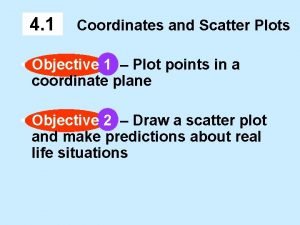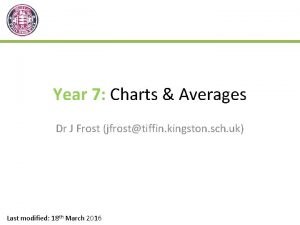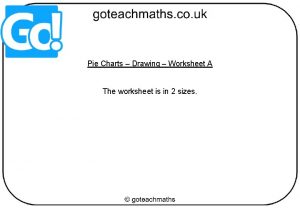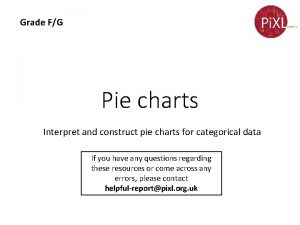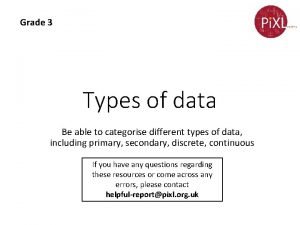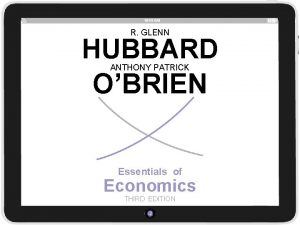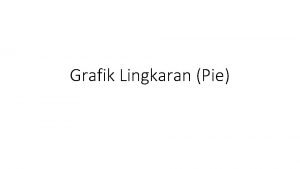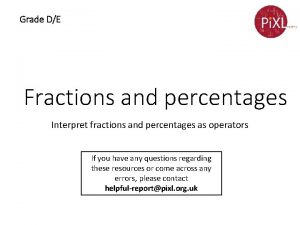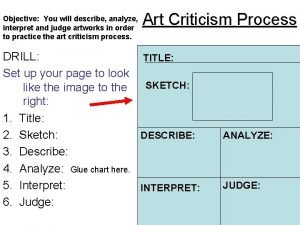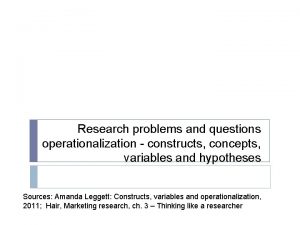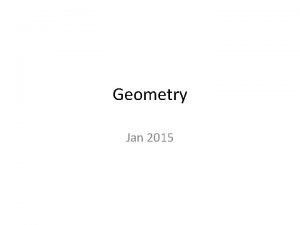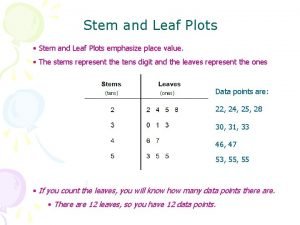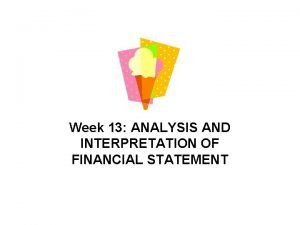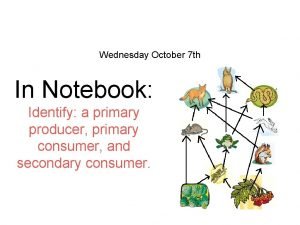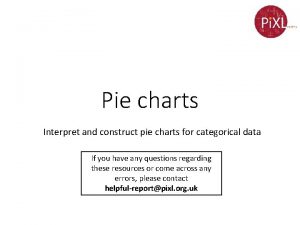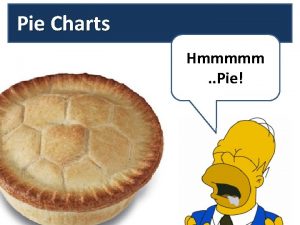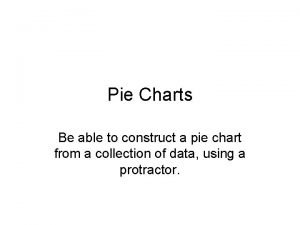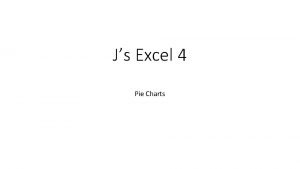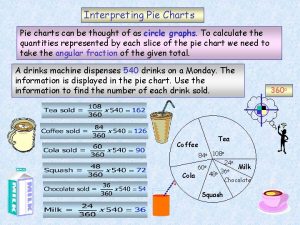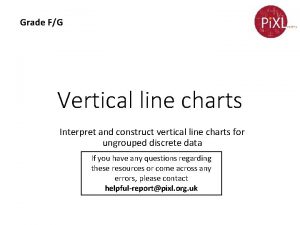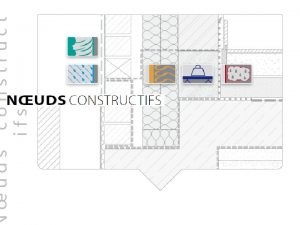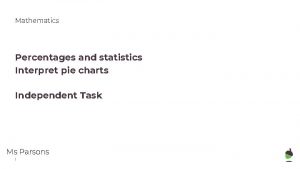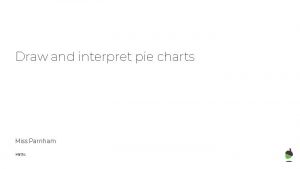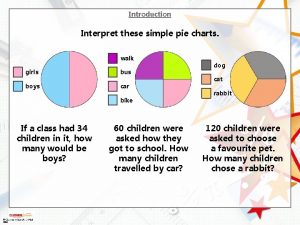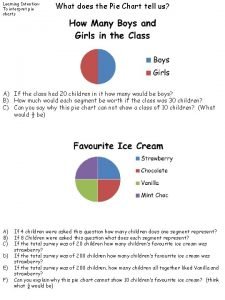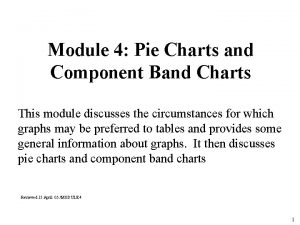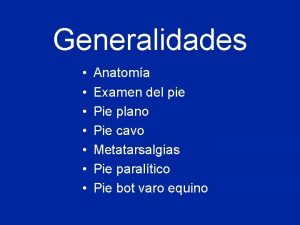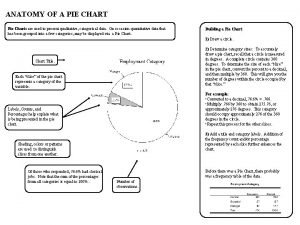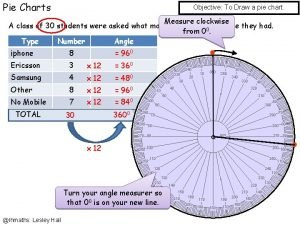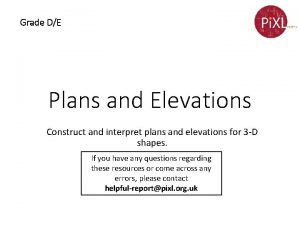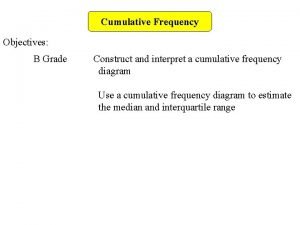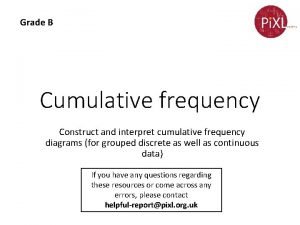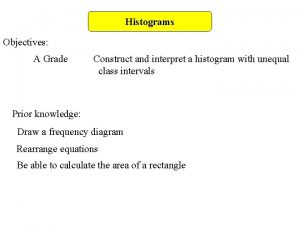Grade FG Pie charts Interpret and construct pie

























- Slides: 25

Grade F/G Pie charts Interpret and construct pie charts for categorical data If you have any questions regarding these resources or come across any errors, please contact helpful-report@pixl. org. uk

Key Vocabulary Pie chart Categorical data Qualitative data Discrete data Proportion Fraction

Pie charts are most usefully used when data is categorical (qualitative) or discrete. They are an alternative method to display data than Bar Charts and Vertical line charts. We draw a circle and split up the areas into the same ratio as the information we are representing.

Example 1 Jerry decides to count the colour of cars passing his house. The results are given below. Colour of car Frequency Lemon Blue Damson 4 6 8 Draw a pie chart of the results.

Example 1 •

Example 1 • Now we are ready to draw our pie chart. We have: Colour Lemon Blue Damson Frequency 4 6 8 Angle of sector 80 120 160 • First draw a circle and mark the centre.

Example 1

Example 1 Now draw a vertical line from the centre to the circumference.

Example 1 Now draw a vertical line from the centre to the circumference.

Example 1 Now carefully measure the angle of the first section, 80∘, and draw in a line to mark this.

Example 1 Now carefully measure the angle of the first section, 80 o, and draw in a line to mark this.

Example 1 Do the same with the other sections:

Example 1 Do the same with the other sections:

Example 1 Finally, label the sectors:

Example 1 Finally, label the sectors: Lemon Damson Blue

Example 2 Sometimes we are given the pie chart, and asked to answer questions about it. The following pie chart was used to display the data from a survey taken amongst a group of Y 10 students

Example 2 What is the most popular food? Favourite food Pizza Curry Burger Healthy The largest slice is ‘Burger’ so that is the most popular food.

Example 2 What is the least popular food? Favourite food Pizza Curry Burger Healthy ‘Healthy’ is the smallest slice, so the least popular food.

Example 2 • Favourite food Pizza Curry Burger Healthy

Now try these…… 1. Draw a pie chart for the following survey of 60 people’s favourite type of tv programme. TV Programme Frequency Drama 12 Sport 30 News 6 Other 12

Now try these…. . 2. The following questions are about this pie chart: (a) Which was the most popular destination? (b) Which two destinations were equally popular? (c) Which was the least popular destination?

Now try these……solutions 1. Draw a pie chart for the following survey of 60 people’s favourite type of tv programme. 360 ÷ 60 = 6 TV Programme Frequency Angle Drama 12 12 x 6 = 72 Sport 30 30 x 6 = 180 News 6 6 x 6 = 36 Other 12 12 x 6 = 72 Total 60

Now try these……solutions 1. Draw a pie chart for the following survey of 60 people’s favourite type of tv programme. 360 ÷ 60 = 6

Now try these…. . solutions 2. The following questions are about this pie chart: (a) Which was the most popular destination? Greece (b) Which two destinations were equally popular? America and Spain (c) Which was the least popular destination? France

Reason and explain How many degrees are there if you turn through a full circle? 360 o What type of data do you use a pie chart for? Qualitative (categorical) data How do the sectors of a pie chart relate to the frequency? The area is in the same ratio as the frequency
 4-1 construct and interpret scatter plots
4-1 construct and interpret scatter plots Gcse pie charts
Gcse pie charts Dr frost averages
Dr frost averages Constructing pie charts worksheet
Constructing pie charts worksheet Vertical pie chart
Vertical pie chart Pixi pie charts
Pixi pie charts Pie charts in r
Pie charts in r Contoh diagram pie
Contoh diagram pie Qualitative and quantitative research
Qualitative and quantitative research Fraction to percentage table
Fraction to percentage table The ability to locate interpret and apply information
The ability to locate interpret and apply information The ability to locate interpret and apply information
The ability to locate interpret and apply information Art with description
Art with description Describe the picture
Describe the picture Find the mean absolute deviation
Find the mean absolute deviation Interpret and analyze
Interpret and analyze Conceptualization and operationalization in research
Conceptualization and operationalization in research In isosceles trapezoid qrst shown below qr and ts are bases
In isosceles trapezoid qrst shown below qr and ts are bases Stem and leaf diagram
Stem and leaf diagram Grading system deped
Grading system deped What is the white part of an egg called
What is the white part of an egg called Low grade and high grade metamorphic rocks
Low grade and high grade metamorphic rocks How to interpret quick ratio
How to interpret quick ratio Identify
Identify Dr shaffi
Dr shaffi How does sociology interpret hate crimes
How does sociology interpret hate crimes
